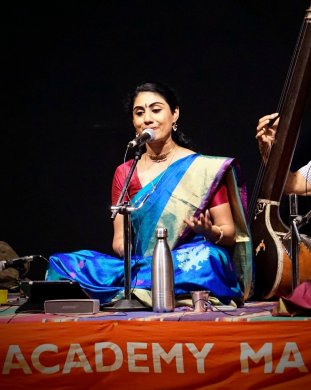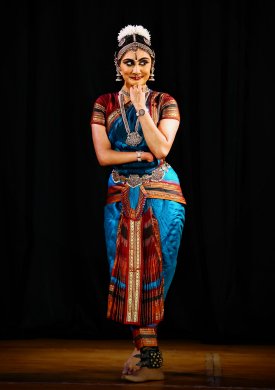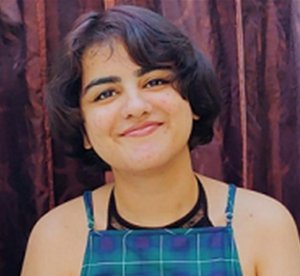
|
 |

|
 |
Sutikshna Veeravalli: Dance and dissolution of boundaries - Rolie Breja e-mail: roliebreja@gmail.com December 7, 2021 "I grew up with a purist mentality because, somewhere, I knew I would be judged if I didn't. I wonder if most people who consider themselves purist defend that identity because that's the expectation they sense from others... that that's how a specific group of others would like them to be, in order to retain legitimacy. Ultimately, I don't consider myself a purist anymore. There is a sense of elitism and power it stems from. And I would like to stem from inclusion, instead," says Sutikshna Veeravalli, an Indian dancer in Chicago, US, who has grown up there, as a person and as an artist. She has been pursuing Bharatanatyam and Carnatic vocal music for over 20 years.  Dissolution of boundaries within the arts has given different shapes and forms to every art form. Whether the new form complies with the principles of parent art form, and if that makes its existence valid, is the question. Sutikshna V. has grown up with the American citizens in the US and Indian citizens in the US. People around her who have been exposed to Bharatanatyam and Carnatic music have had different experiences of both. "One thing I think is intertwined with my experience of the arts is that I was born physically differently abled. And one thing that [it] allows me to do is, whenever I see someone who may appear unexpected, I give them a chance. I don't think that is a default reaction, even when people see me dancing. I think it also applies to someone who appears Chinese or white and is seen dancing Bharatanatyam. There is always a qualified success, assuming that whatever they do is more imitative than internalized. The way I see it is a little different than this perspective I've seen others adopt. I try to not assume that this person is just going through the motions, or that they probably don't understand, or that they couldn't have possibly fully absorbed this dance form. All those statements believe that someone can be too different to ever be authentic or have their own space within the art form. So when I see someone unexpected, I think I try to give them a chance anyway.... because maybe this is something that means a lot to them." Sutikshna talks about her experience growing up with the arts. "My mother has always been my dance teacher. I inevitably grew up with these two art forms in the household, which was very different from many other Indian American children born and brought up in this country. I am definitely in the minority of my own minority demographic. Growing up, I found a group of people who were also pursuing Carnatic music and/or Bharatanatyam. That group became the one I relate to the most. I think that has a lot to do with my upbringing. I wasn't the kind of child to go out and ask my parents for what all the other teenagers were asking for- no flashy clothes or parties. I grew up in a household where music, dance, and modesty were common and prioritized. You'd be able to go around the house and always hear some CD playing in the background, some concert going on. Dance class kids would come to our house all the time." Is there a formula for truly knowing the art form that you pursue, or is it possible to fully know anything at all in this neo-information era? There is no formula but knowing the language and mythology of the place plays an important role. "For some context, language and mythology exposure at my formative ages was helpful to form a relationship with the art content. When I was younger, I apparently grew such an affinity for the Ramayana that I refused to eat without simultaneously hearing stories from it. My grandmother also came and stayed for a long time when I was just born and growing up; she made Tamil language and customs feel regular. We also travelled to India almost yearly, through which it became natural for me to code switch. [Around the world] you see many people who have been trained in dance and may look neat and impressive. But does every performance I watch give me a sense of fulfillment? Not necessarily. I'd like to think that fulfillment comes from watching someone to whom dancing is an act of joy and immersion- which is a more unscripted relationship- and not accuracy which is a more scripted relationship. One of these approaches to dance is kinder towards inclusion. Unless you see them put their life and soul into it, there's... We're inclined to call it dance, simply because it meets the minimal criteria of Bharatanatyam grammar."  Art cannot and does not have to belong to a place, race or time period. It's ever flowing and ever reaching out. If you choose to let it grip you, and you mix it with other art forms that have taken a hold of you, what becomes of it is a "fusion." Sutikshna has a take on the same. "People often conflate technique and style. A lot of people, unfortunately, have seen people, who are not so well versed in the technique, doing fusion based things and assume that fusion itself is a lesser concept. We have people who have kind of learned Carnatic music and do some kind of fusion with western music. It's easy to judge that fusion itself as bad, but what they may actually mean is that the person hasn't baked in the classical technique so much, yet, to present a more thoughtful or integrated piece. But I think recently, especially during covid times, I've seen a lot more well-trained people do fusion things. And so that has kind of debunked this myth. Fusion is no longer bad. I've seen more and more people, during this time especially, just doing what moves them. You kind of reach a point where you're like, you know what? They're all happy. Why am I bothering judging them?" Talking about working with kids on the autism spectrum, Sutikshna mentions, "For me dance is the concept of finding pleasure in movement and making a routine out of that. I work with kids on the autism spectrum and there's this movement called 'stimming.' Stimming is a repetitive behavior that they often do with their hands. To me that's dance. They stim as a response to times of stress or excitement or any kind of heightened emotion. If that's not dance, what is? They feel like they're expressing themselves, and it's a routine. So, they have found something that gives them a sense of movement pleasure." Sutikshna says that she thinks of dance a little more abstractly. "The first word that comes to my mind when I think of dance as a language on my body is, 'inevitable.' I think that is not just for me as someone who has been trained in dance but also for everyone." We get defensive about what belongs to us and what we belong to. An art form does not have to be one of them.  Rolie Breja is a Communication student from Mount Carmel College, Bangalore. She loves reading and writing about music and films, with her special interest in diasporic cultures. You can find her on instagram @roliebreja. Post your comments Please provide your name and email id when you use the Anonymous / blog profiles to post a comment. All appropriate comments posted with name and email id in the blog will be featured in the site. |